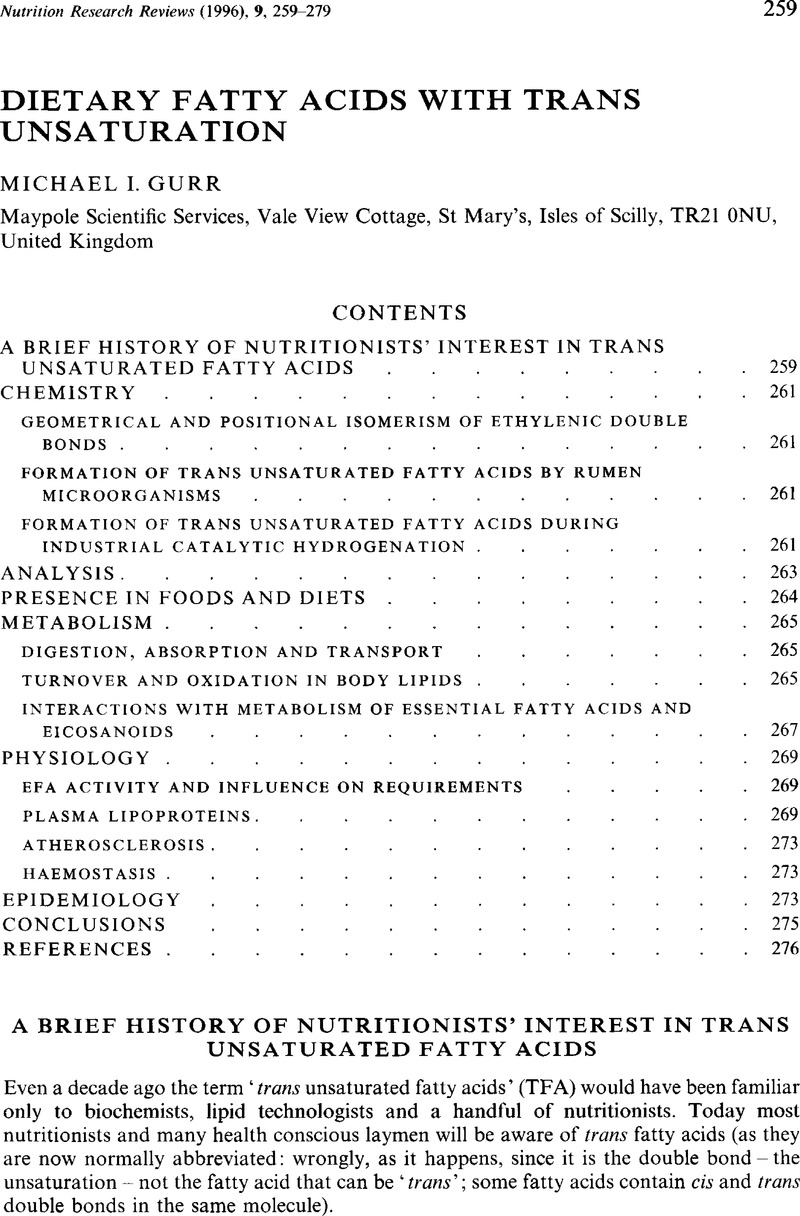Crossref Citations
This article has been cited by the following publications. This list is generated based on data provided by Crossref.
Sadler, M.J.
1998.
Encyclopedia of Human Nutrition.
p.
230.
Ovesen, Lars
Leth, Torben
and
Hansen, Kirsten
1998.
Fatty acid composition and contents of trans monounsaturated fatty acids in frying fats, and in margarines and shortenings marketed in Denmark.
Journal of the American Oil Chemists' Society,
Vol. 75,
Issue. 12,
p.
1079.
Ovesen, Lars
Leth, Torben
and
Hansen, Kirsten
1998.
Fatty acid composition and contents of trans monounsaturated fatty acids in frying fats, and in margarines and shortenings marketed in Denmark.
Journal of the American Oil Chemists' Society,
Vol. 75,
Issue. 9,
p.
1079.
2000.
Chemie in Lebensmitteln.
p.
287.
Gurr, Michael I.
2000.
Handbook of Olive Oil.
p.
521.
2002.
Lipid Biochemistry.
p.
127.
2002.
Lipid Biochemistry.
p.
170.
Bhanger, Muhammad Iqbal
and
Anwar, Farooq
2004.
Fatty acid (FA) composition and contents of trans unsaturated FA in hydrogenated vegetable oils and blended fats from Pakistan.
Journal of the American Oil Chemists' Society,
Vol. 81,
Issue. 2,
p.
129.
Cantwell, M. M.
Flynn, M. A. T.
Cronin, D.
O'Neill, J. P.
and
Gibney, M. J.
2005.
Contribution of foods to trans unsaturated fatty acid intake in a group of Irish adults.
Journal of Human Nutrition and Dietetics,
Vol. 18,
Issue. 5,
p.
377.
Karabulut, I.
and
Turan, S.
2006.
Some properties of margarines and shortenings marketed in Turkey.
Journal of Food Composition and Analysis,
Vol. 19,
Issue. 1,
p.
55.
Jensen, Robert
and
Palmquist, Donald
2007.
Fatty Acids in Foods and their Health Implications,Third Edition.
Vol. 20073230,
Issue. ,
p.
109.
Teodorescu, Carmen
and
Craig-Schmidt, Margaret
2007.
Fatty Acids in Foods and their Health Implications,Third Edition.
Vol. 20073230,
Issue. ,
p.
377.
Fernández-Michel, S. G.
García-Díaz, C. L.
Alanís-Guzmán, M. G.
and
Ramos-Clamont, M. G.
2008.
ÁCIDOS GRASOSTRANS: CONSUMO E IMPLICACIONES EN LA SALUD EN NIÑOSTRANSFATTY ACID: INTAKE AND IMPLICATIONS FOR CHILD HEALTH.
Ciencia y Tecnologia Alimentaria,
Vol. 6,
Issue. 1,
p.
71.
Ragonese, Carla
Tranchida, Peter Quinto
Dugo, Paola
Dugo, Giovanni
Sidisky, Leonard M.
Robillard, Mark V.
and
Mondello, Luigi
2009.
Evaluation of Use of a Dicationic Liquid Stationary Phase in the Fast and Conventional Gas Chromatographic Analysis of Health-Hazardous C18 Cis/Trans Fatty Acids.
Analytical Chemistry,
Vol. 81,
Issue. 13,
p.
5561.
Sinanoglou, Vassilia J.
Konteles, Spyros
Batrinou, Anthimia
Mantis, Fotis
and
Sflomos, Konstantinos
2009.
Effects of Gamma Radiation on Microbiological Status, Fatty Acid Composition, and Color of Vacuum-Packaged Cold-Stored Fresh Pork Meat.
Journal of Food Protection,
Vol. 72,
Issue. 3,
p.
556.
Gurr, Michael I.
2012.
Lipids in Nutrition and Health.
p.
1.
Peskin, Brian Scott
2013.
RETRACTED: SELECT Trial Results Examined: Why Fish Oil, DHA and “Oily Fish” Are Inflammatory, Leading to Increases in Prostate Cancer, Epithelial Cancers and CVD.
Food and Nutrition Sciences,
Vol. 04,
Issue. 11,
p.
1128.
Peskin, B. S.
2014.
Why Fish Oil Fails: A Comprehensive 21st Century Lipids-Based Physiologic Analysis.
Journal of Lipids,
Vol. 2014,
Issue. ,
p.
1.
Markey, Oonagh
and
Kliem, Kirsty E.
2020.
Milk and Dairy Foods.
p.
51.





